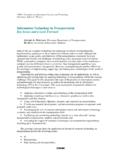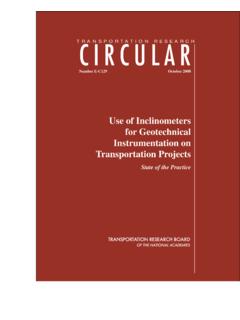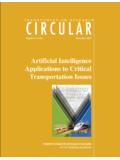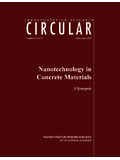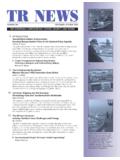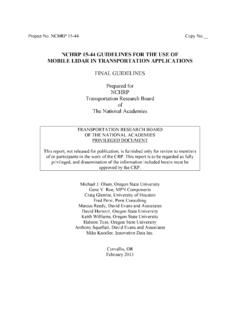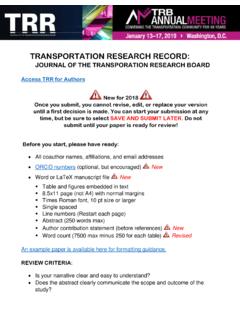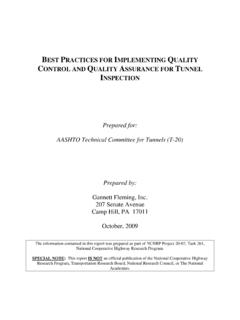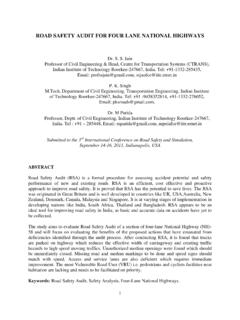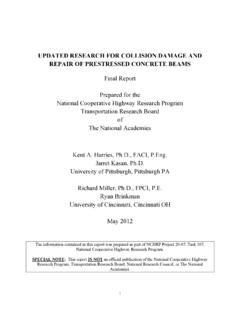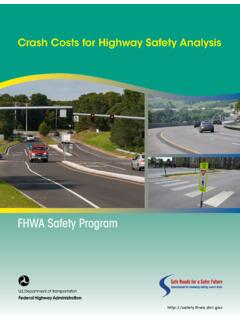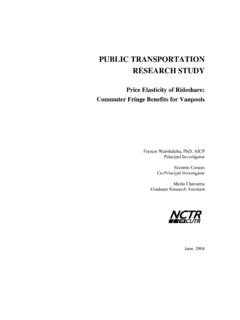Transcription of CONSTRUCTION GUIDELINES FOR WILDLIFE FENCING AND ...
1 CONSTRUCTION GUIDELINES FOR WILDLIFE . FENCING AND ASSOCIATED ESCAPE AND. LATERAL ACCESS CONTROL MEASURES. Requested by: American Association of State Highway and transportation Officials (AASHTO). Standing Committee on the Environment Prepared by: Marcel P. Huijser, Angela V. Kociolek, Tiffany Allen, Patrick McGowen Western transportation Institute Montana State University PO Box 174250. Bozeman, MT 59717-4250. Patricia C. Cramer 264 E 100 North, Logan, Utah 84321. Marie Venner Lakewood, CO 80232. April 2015. The information contained in this report was prepared as part of NCHRP Project 25-25, Task 84, National Cooperative Highway Research Program, transportation Research Board. SPECIAL NOTE: This report IS NOT an official publication of the National Cooperative Highway Research Program, transportation Research Board, National Research Council, or The National Academies.
2 WILDLIFE FENCING and Associated Measures Disclaimer DISCLAIMER. DISCLAIMER STATEMENT. The opinions and conclusions expressed or implied are those of the research agency that performed the research and are not necessarily those of the transportation Research Board or its sponsors. The information contained in this document was taken directly from the submission of the author(s). This document is not a report of the transportation Research Board or of the National Research Council. ACKNOWLEDGEMENTS. This study was requested by the American Association of State Highway and transportation Officials (AASHTO), and conducted as part of the National Cooperative Highway Research Program (NCHRP) Project 25-25 Task 84. The NCHRP is supported by annual voluntary contributions from the state Departments of transportation . Project 25-25 is intended to fund quick response studies on behalf of the AASHTO Standing Committee on the Environment.
3 The work was guided by a panel chaired by Todd Williams. Other panel members were Gail Anne D'Avino, Timothy Dexter, Norris Dodd, Jeff Gagnon, Todd Nichols, Kelly McAllister, Stirling Robertson, William C. Ruediger, and Leonard Sielecki, and Bill Ostrum was the FHWA liaison. The project was managed by Nanda Srinivasan and Crawford Jencks from NCHRP. Western transportation Institute Page 2. WILDLIFE FENCING and Associated Measures Table of Contents TABLE OF CONTENTS. 1. Introduction ..15. Background .. 15. Overview and Purpose of the Mitigation Measures Included in this Report .. 16. Organization of the Report .. 17. 2. Literature Organization of Literature 18. Keep WILDLIFE Off the Road .. 18. Fence Location and Length .. 18. Where to Start, Where to Stop? .. 19. Fence Material and 19. Fence End 23. Access Road Treatments .. 25. Effectiveness in Reducing Collisions.
4 26. WILDLIFE Mortality as a Result of WILDLIFE Crashing into Fences .. 27. Landscape Aesthetics .. 28. 28. Maintenance .. 29. Allow WILDLIFE to Escape the Fenced Road Corridor .. 30. General Considerations .. 30. Passive One-Way Gates .. 31. Active One-Way Gates .. 31. WILDLIFE Jump-outs or Escape Ramps .. 32. Branches Stacked Against Fence .. 33. Lower Fences with Outrigger .. 33. Warn Drivers and Traffic Calming in Fenced Road Corridor .. 34. Warning signs .. 34. Traffic Calming .. 36. Allow Humans to Get In and Out of the Fenced Road 36. General .. 36. Non-Motorized Use (Pedestrians, Bicyclists, Equestrian) .. 36. Motorized Use .. 38. 3. Survey ..40. Organization of Survey .. 40. Methods .. 40. The Target 40. Survey Development and Review .. 41. Respondents .. 42. Large and Medium-Sized Mammals .. 46. Characteristics of the Respondents .. 46. Measures to Keep Large and Medium-Sized Mammals Off the Road.
5 46. Allow WILDLIFE to Escape the Fenced Road Corridor .. 55. Keep WILDLIFE Out of Fenced Road Corridor at Fence Gaps and Fence Ends .. 59. Allow Humans to Get In and Out of the Fenced Road Corridor .. 64. At Grade Crossing Opportunities for WILDLIFE at Gaps or Fence Ends .. 69. Western transportation Institute Page 3. WILDLIFE FENCING and Associated Measures Table of Contents Amphibians and Reptiles .. 76. Characteristics of the Respondents .. 76. Measures to Keep Amphibians and Reptiles Off the Road .. 77. Allow WILDLIFE to Escape the Fenced Road Corridor .. 85. Keep WILDLIFE Out Off Fenced Road Corridor at Fence Gaps and Fence Ends .. 87. Allow Humans to Get In and Out of the Fenced Road Corridor .. 89. At Grade Crossing Opportunities for WILDLIFE at Gaps or Fence Ends .. 93. Design Plans and Specifications .. 96. Introduction .. 96. Wire Mesh FENCING for Large Animals.
6 97. Other Details .. 112. Small Animals .. 113. 4. Cost-Benefit Analyses ..115. Introduction .. 115. Methods .. 115. Results .. 118. Discussion and Conclusions .. 120. Cost Estimates for the Mitigation Measures .. 120. Mitigation Packages 120. Relative Costs per Kilometer Road Length Mitigated .. 120. 5. Recommendations ..121. Recommendations vs. Best Management Practices .. 121. Design Recommendations .. 121. Always Combine WILDLIFE Fences with Safe Crossing Opportunities .. 121. Define the Problem and Select the Mitigation Measures 123. The Context of the Landscape .. 124. Decide on the Spatial Configuration of the Mitigation Measures .. 125. Fence Length .. 125. Fence Configurations and Fence End Locations .. 126. Target Species and Design of the FENCING .. 127. Climate and Other Abiotic Processes and Design Considerations .. 133. Implementation Recommendations.
7 134. Maintenance Recommendations .. 136. 6. Gaps in Knowledge ..137. Need for Comparative Studies .. 137. Suitability for the Target Species .. 137. Minimum Fence Length and the Importance of Fence End Treatments.. 138. Human Access Points.. 138. Design of WILDLIFE Guards .. 138. WILDLIFE Jump-outs .. 139. Amphibians and Reptiles .. 139. 7. References ..141. 8. Appendix A: Survey ..152. 9. Appendix B: Other Responses and Comments ..184. 10. Appendix C: Additional Information For Effective or Ineffective Designs ..211. C-1: Mammal Fence Designs .. 211. Western transportation Institute Page 4. WILDLIFE FENCING and Associated Measures Table of Contents C-2: Mammal Escape Designs (Jump Down to the Safe Side of the Fence) .. 213. C-3: Mammal Escape Designs (Do Not Jump Up into the Fenced Corridor) .. 214. C-4: Mammal Fence Gap Treatments .. 215. C-5: Mammal Fence End and Gap Treatments (Pavement Edge and Fence Line).
8 216. C-6: Mammal Fence End / Gap Treatments on Travel Lanes .. 217. C-7: Amphibian / Reptile Fence Designs .. 218. Western transportation Institute Page 5. WILDLIFE FENCING and Associated Measures List of Tables LIST OF TABLES. Table 1: The suitability of different types of access facilities in and out of fenced road corridors for pedestrians, bicyclists, and equestrian use.. 37. Table 2: The suitability of different types of access facilities in and out of fenced road corridors for motorized 39. Table 3: US state and Canadian province representation.. 44. Table 4: Post/fence material combinations (blackened areas) reported for excluding mammals. 48. Table 5: Characteristics of at-grade crossing opportunities at fence gaps per target mammal species.. 74. Table 6: Responses pertaining to escape design, placement, height, effectiveness and cost per amphibian/reptile species.
9 Note: 15 respondents answered this question but each respondent could enter multiple responses. Only those entries with information are included. Refer to Appendix B-Question 25 for other escape designs or rationale for why no escape design is implemented.. 85. Table 7: Responses pertaining to fence end/gap treatments (on travel lanes), clearance distance, effectiveness and cost per amphibian/reptile species. Note: There were only two responses for this topic.. 94. Table 8: Summary of plans reviewed.. 96. Table 9: Fence post type and spacing.. 102. Table 10: Costs associated with various mitigation measures based on the survey (this) report). and an earlier publication (Huijser et al., 2009a).. 116. Table 11: Standardized costs for WILDLIFE FENCING , fence end treatment, underpass and WILDLIFE jump-pouts used for the analyses in this report.. 116. Table 12: Mitigation packages included in the cost-benefit analyses and the functions included in the individual packages.
10 117. Table 13: Threshold values for four different types and combinations of mitigation measures (each of these is estimated to reduce collisions with large ungulates by 86% (see review in Huijser et al., 2009a).. 118. Table 14: WILDLIFE fence design recommendations for fence design for ungulates (Partially based on Kruidering et al., 2005; Clevenger & Huijser, 2011).. 128. Table 15: WILDLIFE fence design recommendations for fence design for carnivores (Partially based on Kruidering et al., 2005; Clevenger & Huijser, 2011).. 129. Table 16: WILDLIFE fence design recommendations for fence design for amphibians and reptiles (Partially based on Kruidering et al., 2005; Clevenger & Huijser, 2011).. 130. Table 17: Fence end and access point recommendations for different species and species groups.. 131. Table 18: Escape opportunities for WILDLIFE from the right-of-way.. 131.)
